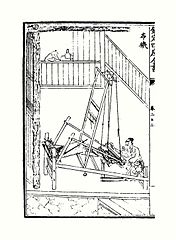
Yuan dynasty
The Yuan dynasty (Chinese: 元朝; pinyin: Yuáncháo), officially the Great Yuan[10] (Chinese: 大元; pinyin: Dà Yuán; Mongolian: ᠶᠡᠬᠡ
ᠶᠤᠸᠠᠨ
ᠤᠯᠤᠰ, Yeke Yuwan Ulus, literally "Great Yuan State"[note 4]), was a Mongol-led imperial dynasty of China and a successor state to the Mongol Empire after its division.[note 2] It was established by Kublai (Emperor Shizu or Setsen Khan), the fifth khagan-emperor of the Mongol Empire from the Borjigin clan, and lasted from 1271 to 1368. In Chinese history, the Yuan dynasty followed the Song dynasty and preceded the Ming dynasty.
Great Yuan
Khagan-ruled division of the Mongol Empire[note 2]
Conquest dynasty of Imperial China
Buddhism (Tibetan Buddhism as de facto state religion), Confucianism, Taoism, Shamanism, Mongolian Tengrism/Chinese Heaven worship, Chinese folk religion, Chinese Nestorian Christianity, Roman Catholic Christianity, Judaism, Chinese Manichaeism, Islam
5 May 1260
5 November 1271
1268–1273
4 February 1276
19 March 1279
1351–1368
14 September 1368
1368–1388
11,000,000 km2 (4,200,000 sq mi)
Jiaochao banknotes, Chinese cash
Although Genghis Khan's enthronement as Khagan in 1206 was described in Chinese as the Han-style title of Emperor [note 3][6] and the Mongol Empire had ruled territories including modern-day northern China for decades, it was not until 1271 that Kublai Khan officially proclaimed the dynasty in the traditional Han style,[13] and the conquest was not complete until 1279 when the Southern Song dynasty was defeated in the Battle of Yamen. His realm was, by this point, isolated from the other Mongol-led khanates and controlled most of modern-day China and its surrounding areas, including modern-day Mongolia.[14] It was the first dynasty founded by a non-Han ethnicity that ruled all of China proper.[15]: 312 [16] In 1368, following the defeat of the Yuan forces by the Ming dynasty, the Genghisid rulers retreated to the Mongolian Plateau and continued to rule until 1635 when they surrendered to the Later Jin dynasty (which later evolved into the Qing dynasty). The rump state is known in historiography as the Northern Yuan dynasty.
After the division of the Mongol Empire, the Yuan dynasty was the khanate ruled by the successors of Möngke. In official Chinese histories, the Yuan dynasty bore the Mandate of Heaven. The dynasty was established by Kublai Khan, yet he placed his grandfather Genghis Khan on the imperial records as the official founder of the dynasty and accorded him the temple name Taizu.[note 3] In the edict titled Proclamation of the Dynastic Name issued in 1271,[8] Kublai announced the name of the new dynasty as Great Yuan and claimed the succession of former Chinese dynasties from the Three Sovereigns and Five Emperors to the Tang dynasty.[8] Some of the Yuan emperors mastered the Chinese language, while others only used their native Mongolian language and the 'Phags-pa script.[17]
Kublai, as a Khagan (Great Khan) of the Mongol Empire from 1260, had claimed supremacy over the other successor Mongol khanates: the Chagatai, the Golden Horde, and the Ilkhanate, before proclaiming as the Emperor of China in 1271. As such, the Yuan was also sometimes referred to as the Empire of the Great Khan. However, while the claim of supremacy by the Yuan emperors was at times recognized by the western khans, their subservience was nominal and each continued its own separate development.[18][19]
Yuan dynasty
元朝
"Yuan dynasty"
Yuán cháo
Yuán cháo
ㄩㄢˊ ㄔㄠˊ
Yüan2 ch‘ao2
Yuán cháo
Nyœ́ záu
Yùhn chìuh
Jyun4 ciu4
Guân tiâo
大元
Great Yuan
Dà Yuán
Dà Yuán
ㄉㄚˋ ㄩㄢˊ
Ta4 Yüan2
Dà Yuán
daai6 jyun4
大元大蒙古國
大元大蒙古国
"Great Yuan" (Middle Mongol transliteration of Chinese "Dà Yuán") Great Mongol State
Dà Yuán Dà Měnggǔ Guó
Dà Yuán Dà Měnggǔ Guó
ㄉㄚˋ ㄩㄢˊ ㄉㄚˋ ㄇㄥˇ ㄍㄨˇ ㄍㄨㄛˊ
Ta4 Yüan2 Ta4 Meng3-ku3 Kuo2
Dà Yuán Dà Měng-gǔ Guó








![Chuangzi Nu (Yuan dynasty)[163]](http://upload.wikimedia.org/wikipedia/commons/thumb/8/84/Chuangzi_Nu1.jpg/211px-Chuangzi_Nu1.jpg)





